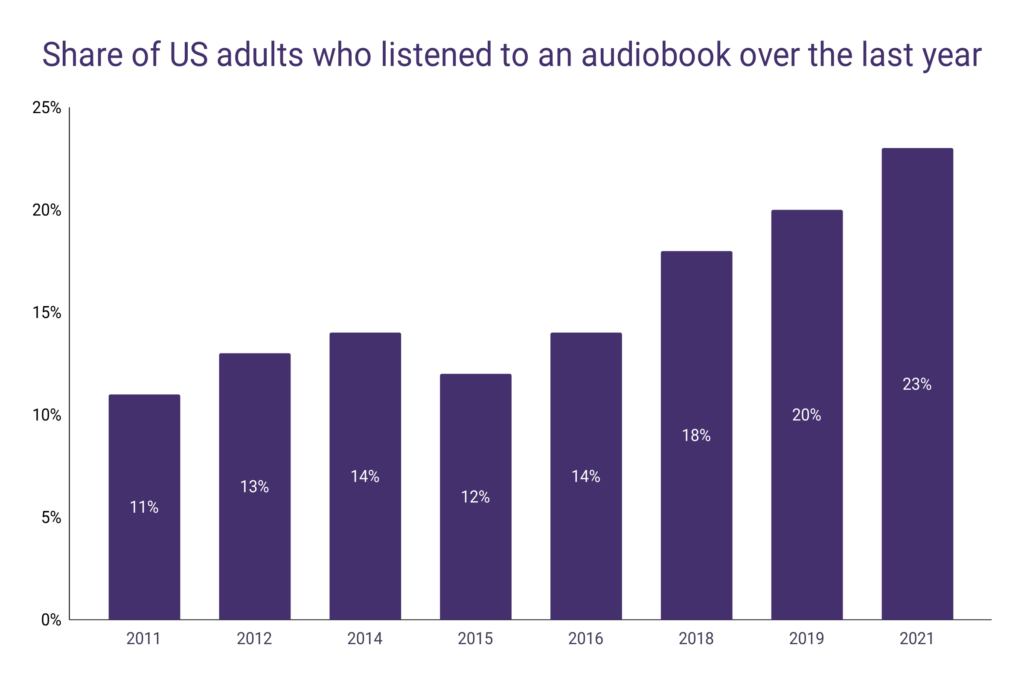Book publishing has gone through some major innovations over the last decade. After the emergence of ebooks in the early years of the 2000s, it was projected that this format would take over the book publishing world. In the meantime, audiobooks appeared on the scene, and they’re already surpassing the ebook market.
As audiobooks become the fastest-growing segment in book publishing, we decided to take a detailed look into the audiobook industry and create a report outlining all the important aspects of this format. We discuss the overall market, sales statistics, and the listening habits of audiobook consumers.
Audiobook market
Audiobooks are the fastest-growing format in the publishing industry and will be the driving force behind the growth of book publishing over the next decade. Even during the pandemic year, when print books were leading the industry’s growth, audiobooks still grew by over 10%.
- The global audiobook market is worth over $5.3 billion and is projected to reach $35 billion in 2030.
- This means that the audiobook market will grow by 26.4% every year over the next 7 years, while the book publishing market will grow by 1.9%.
- Audiobook revenue accounted for around 3.8% of the book publishing revenue in 2022 and is projected to rise to 4.73% in 2023.
- In 2027, the audiobook share in the global publishing market will go over 10% for the first time.
- By 2030, the projections show that audiobooks will account for over 21.3% of the global book publishing revenue.
| Year | Audiobook market ($ billion) | Book market overall ($ billion) | Share of audio |
| 2022 | $5.38 | $140.98 | 3.82% |
| 2023 | $6.80 | $143.66 | 4.73% |
| 2024 | $8.59 | $146.39 | 5.87% |
| 2025 | $10.86 | $149.17 | 7.28% |
| 2026 | $13.73 | $152.00 | 9.03% |
| 2027 | $17.36 | $154.89 | 11.21% |
| 2028 | $21.94 | $157.83 | 13.90% |
| 2029 | $27.73 | $160.83 | 17.24% |
| 2030 | $35.05 | $163.89 | 21.39% |

Audiobook sales
Since the data on the exact number of streamed or sold audiobooks sold, we have to rely on revenue figures to see how the audiobook sales changed over time. Unsurprisingly, the growth is continuously positive and usually exceeds 20% annually.
- Over $1.81 billion was generated through audiobook sales in the United States in 2022. The sales grew by 3.43% over 2021, which was the slowest year for this format.
- Sales revenue for audiobooks in the US increased by over 50% over the last 5 years.
- 9% of all book sales in the US are coming from audiobooks as of 2022.
- Fiction audiobooks account for over 65% of all sales within the format, but nonfiction is growing by 27.5% annually.
- Audiobook revenue passed the ebook revenue for the first time in 2019, and the gap has kept getting bigger ever since.
- Over 74,000 audiobooks were published in the US in 2022.

China is the biggest audiobook market outside the US, followed by Europe. Nordic countries are especially popular markets for audiobooks and are projected to be among the fastest-growing markets in the audiobook section.
- Over 569 million Chinese citizens listened to an audiobook in 2020, more than double that of 2016.
- The European audiobook market is worth over $850 million and is expected to grow by 18.6% every year until 2025.
- Germany controls over 32% of the European audiobook market.
Audiobook listening habits
The format of audiobooks allows listeners to use their time for other activities while listening, which gives audiobooks a unique advantage over print and ebook formats. Because of this, listening to audiobooks is more accessible in everyday situations and enables users to develop unique habits while consuming books.
- Over 23% of Americans listened to at least one audiobook in 2021, 15% more than in 2020.
- Over the last 10 years, the share of US adults who listen to audiobooks has grown by more than 100%.
- Over 45% of Americans have listened to an audiobook at least once in their life as of 2022.
- Women listen to audiobooks more than men. They are 13.6% more likely to consume audio content.
- Black adults in the USA listen to audiobooks the most, relative to their population. Over 26% of African Americans listened to audiobooks over the last 12 months.
- Younger people are more likely to consume audio format, as 57% of Americans younger than 50 listened to audiobooks in 2021.

Audiobooks in Audible
As the biggest name in the audiobook publishing industry, Audible is generating the majority of the industry’s revenue. This platform has taken over the audiobook segment over the last five years, separating itself from the competition by a wide margin.
- With $1.01 billion generated through audiobook sales and subscription services, Audible controls over 63.4% of the US audiobook market.
- 5 years ago, the company’s share in the market was 41%, meaning that the company’s share in the audiobook market has increased by 57% since 2018.
- At the same time, Audible accounts for only 13.5% of the total number of audiobooks published in a year.
- This means that Audible generates twice as many per sold audiobook compared to the rest of the industry.
An Audible narrator will speak around 155 words per minute.
How much does it cost to publish an audiobook?
Audiobook production is a multi-step process that requires equipment, software, a studio, and a narrator. Depending on the cost and availability of each of these aspects, the price of producing an audiobook can vary.
- Generally, around 9,300 words of text equate to one hour of audiobook length.
- The average audiobook is around 10 hours long, containing close to 100,000 words.
- The average narrator charges around $200 per finished hour, meaning that the expenses on the narrator will amount to $2,000 for recording an audiobook.
- On top of that, it is necessary to either rent a studio where the recording will take place or invest in the equipment and sound production yourself.
- In either case, producing an audiobook will take between $4,000 and $8,000.
- Some companies offer a complete production service for a fixed price, usually at the $6,000 range.

